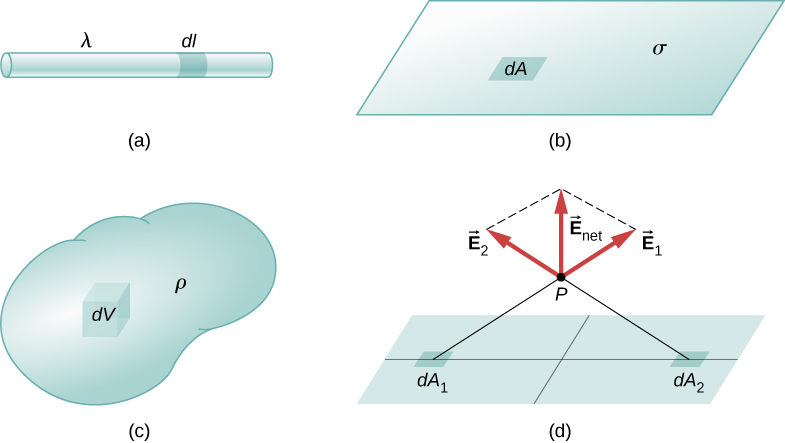| << Chapter < Page | Chapter >> Page > |
The charge distributions we have seen so far have been discrete: made up of individual point particles. This is in contrast with a continuous charge distribution , which has at least one nonzero dimension. If a charge distribution is continuous rather than discrete, we can generalize the definition of the electric field. We simply divide the charge into infinitesimal pieces and treat each piece as a point charge.
Note that because charge is quantized, there is no such thing as a “truly” continuous charge distribution. However, in most practical cases, the total charge creating the field involves such a huge number of discrete charges that we can safely ignore the discrete nature of the charge and consider it to be continuous. This is exactly the kind of approximation we make when we deal with a bucket of water as a continuous fluid, rather than a collection of molecules.
Our first step is to define a charge density for a charge distribution along a line, across a surface, or within a volume, as shown in [link] .

Definitions of charge density:
Then, for a line charge, a surface charge, and a volume charge, the summation in [link] becomes an integral and is replaced by , , or , respectively:
The integrals are generalizations of the expression for the field of a point charge. They implicitly include and assume the principle of superposition. The “trick” to using them is almost always in coming up with correct expressions for dl , dA , or dV , as the case may be, expressed in terms of r , and also expressing the charge density function appropriately. It may be constant; it might be dependent on location.
Note carefully the meaning of r in these equations: It is the distance from the charge element to the location of interest, (the point in space where you want to determine the field). However, don’t confuse this with the meaning of ; we are using it and the vector notation to write three integrals at once. That is, [link] is actually

Notification Switch
Would you like to follow the 'University physics volume 2' conversation and receive update notifications?